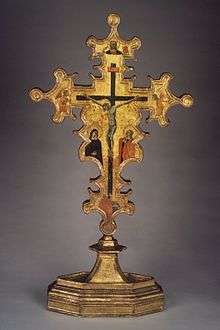Crucifer

A crucifer is, in some Christian churches (particularly the Roman Catholic Church, Anglican Communion, Lutherans, and United Methodist Church), a person appointed to carry the church's processional cross, a cross or crucifix with a long staff, during processions at the beginning and end of the service.[1] However, while it is used in several different denominations, the term is most common within Anglican churches.
The term "crucifer" comes from the Latin crux (cross) and ferre (to bear, carry). It thus literally means "cross-bearer".
Before the Roman Catholic reforms of the Second Vatican Council, the function of the crucifer was generally carried out by a subdeacon. Per the seventeenth century Council of Milan, a crucifer should when possible be a cleric and if a lay person be selected that they "the most worthy of the laity should be selected for the office." For more solemn processions, including the Blessed Sacrament, Palm Sunday, and Candlemas Day, the cleric should be vested in amice, alb, and tunic. While on less solemn occasions, a cleric may just be vested in surplice. During the procession the staff is held with both hands such that the cross is well above the head. The cross-bearer leads the procession except when there is a thurifer and is accompanied by two acolytes on the more solemn occasions.[2]

See also
References
- ↑ Armentrout, Donald S.; Robert Boak Slocum (1999). "Crucifer". An Episcopal Dictionary of the Church: A User-friendly Reference for Episcopalians. Church Publishing, Inc. ISBN 0898697018.
- ↑
 Morrisroe, Patrick (1913). "Cross-Bearer". In Herbermann, Charles. Catholic Encyclopedia. New York: Robert Appleton Company. p. 457.
Morrisroe, Patrick (1913). "Cross-Bearer". In Herbermann, Charles. Catholic Encyclopedia. New York: Robert Appleton Company. p. 457.